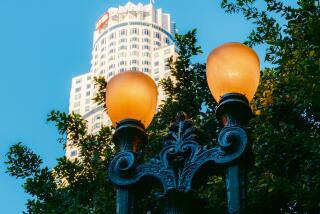LIGHTING : In the Old Days, They Weren’t Too Bright
- Share via
Lighting a period room involves more than finding an original fixture or suitable reproduction.
“Designers now realize that lighting levels are too high,” says Roger W. Moss, author of “Lighting for Historic Buildings” (Preservation Press, $14.95). “They are dropping back general illumination to a softer level and using task lighting for specific jobs.”
They also are using rheostats, known as dimmers; accurate reproductions of lamps; old fixtures that have been reconditioned--and good sense.
The good sense comes in knowing that today’s halogen bulb is far too bright for a Victorian lamp. After all, in the 1880s, a 20-watt bulb was considered a lot of candlepower.
Listen to author Moss, who also is executive director of the Athenaeum in Philadelphia, a research library specializing in 19th-Century cultural and social history:
“In the 19th Century, a gaslight with four burners would have given an equivalent of 80 watts at a maximum. People who convert old fixtures may put 100 watts in every arm.”
Even accurate wattage doesn’t ensure authenticity. Modern bulbs, including incandescents, change the way colors look.
“The modern tungsten filament light bulb doesn’t look that good on an early electric fixture, which would have been supplied with a carbon filament bulb,” Moss says.
While the color problem may never be resolved, Moss says reproduction lighting offers an authentic look and modern convenience.
Reproduction oil lamps from 1800 to 1850 and early gas lamps from 1840 to 1880 are in short supply, Moss says, but there is a variety of gas-electric fixtures, Arts and Crafts style lights and early candle fixtures.
Art Nouveau and Art Deco styles also are numerous, including extraordinary lamps and lighting fixtures designed by Mariano Fortuny (1871-1949), a Spaniard working in Venice. Fortuny is best known for pleated silk fabric, but he also created lighting fixtures, a sconce and lamps with exotic hand-painted silk shades.
Stephanie Odegard offers copies of some of these lights. She brought them from Italy, where they are reproduced, to decorate her New York showroom of Tibetan rugs. Clients liked them so much she started selling them.
The hanging fixtures are hand-painted silk fabric on brass wire, with silk tassels and spun glass beads. Prices for nine models imported in limited quantities range from $600 for a Cesendello floor lamp to $3,700 for a three-tiered ceiling fixture with a shade that is 45 inches wide.
If authentic reproductions are not available in your area, there are plenty of mail-order catalogues. In his book, Moss lists about 100 lighting suppliers, many selling by mail.
The Renovator’s Supply of Millers Falls, Mass., is one such company. It markets more than 50 reproductions and adaptations to complement the catalogue’s other Victorian-style products. The fixtures use standard bulbs up to 60 watts and meet modern safety standards, according to Doug Finck, manufacturing manager.
The company’s most popular lights are copies of fixtures from the turn of the century that worked with either gas or electricity because fledgling city electric systems often broke down. Prices range from about $50 to $260.
When buying by mail, arm yourself with necessary measurements before ordering. For a chandelier over the dining table, for example, the dimensions of the dining table and the height from ceiling to tabletop are critical. Otherwise, says Susan Krawitz Schoenfeld of Classic Designs of Spring Valley, N.Y., you may end up with unnecessary glare and gracelessness.
While authentic reproductions offer convenience, don’t overlook the charm of the real thing.
“Many homeowners are fortunate enough to buy a house which still has the original fixtures,” Moss says. “These almost always can be refinished and cleaned by a specialist. The biggest problem is finding the right kind of glass.”
Restoring an old fixture requires a specialist. You may find one in the yellow pages or through antiques dealers.
Otherwise, ask a manufacturer of reproductions. Some recondition old lamps. If not, they usually know someone who does.
(BEGIN TEXT OF INFOBOX / INFOGRAPHIC)
Illuminating the History of Lamps
Interior lighting changed dramatically in the century prior to 1883, says Roger W. Moss, author of “Lighting for Historic Buildings” (Preservation Press, $14.95).
Until 1783, he says, daylight, candles and oil lamps provided the only illumination. Then, the Argand light was invented. Using whale oil as fuel, it gave off eight times as much light as a candle.
Gaslight gained favor beginning in the 1830s, and by the 1880s it offered enough light to support the use of dark colors and heavy draperies at the windows.
Kerosene ultimately became less expensive than gas and remained in use in rural areas up to the 1940s.
Electric lights were introduced in the 1880s, with an early carbon filament bulb equal to today’s 20-watt bulb.

